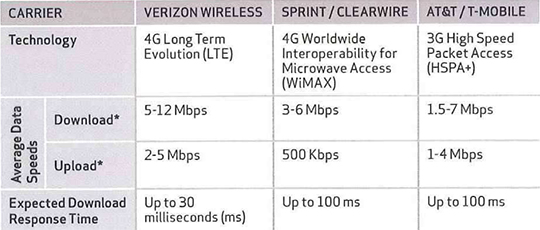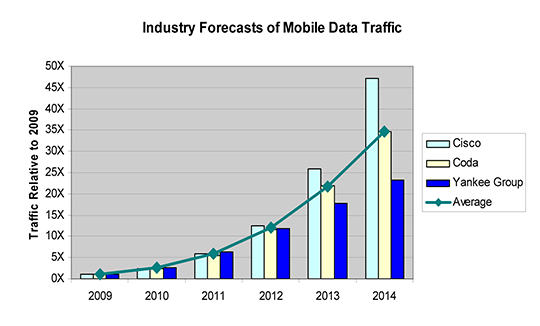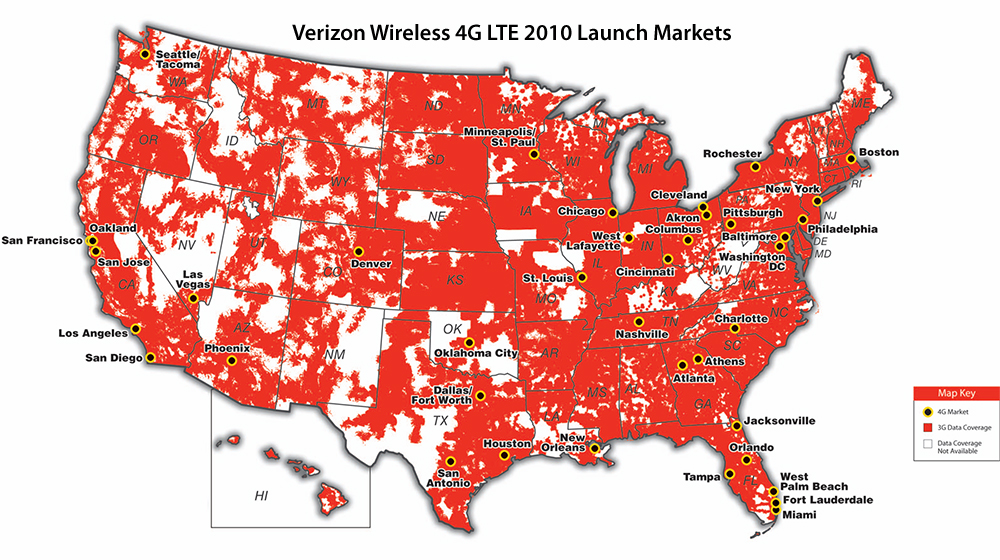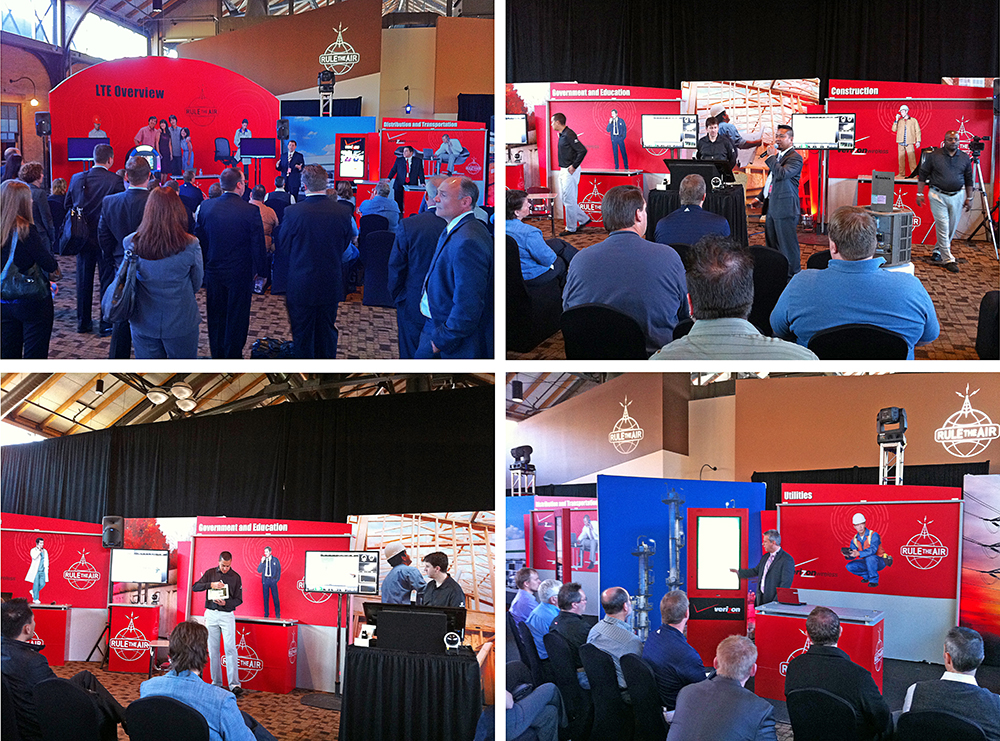 At an event in downtown Minneapolis yesterday, Verizon Wireless announced “the world’s first large-scale 4G Long Term Evolution (LTE) network” to the Twin Cities, slated to come online “before the end of 2010” and will be “the death of the tether” according to Verizon sources at the venue.
At an event in downtown Minneapolis yesterday, Verizon Wireless announced “the world’s first large-scale 4G Long Term Evolution (LTE) network” to the Twin Cities, slated to come online “before the end of 2010” and will be “the death of the tether” according to Verizon sources at the venue.
Graeme Thickins and I attended the event for Minnov8, invited by Albert Maruggi of Provident Partners. Albert was coordinating the blogger outreach and we were thus able to connect with key Verizon Wireless technical staff in order to gain a deeper understanding of what they’ll be delivering on this new 4G infrastructure.
With Sprint and T-Mobile already in this market with their 4G implementations and AT&T coming with theirs in 2011, Verizon’s rollout was expected but both Graeme and I were intrigued by how Verizon Wireless was intending to differentiate themselves in this new 4G LTE space (besides just touting more coverage). What wasn’t expected was how strongly they positioned their IP Multimedia Services (IMS) as “enabling smart services” and APIs they’ll be offering and pushing hard.
For anyone not up-to-speed on all the deliverables, standards and technical aspects of the current state of wireless networking IMS—and the applications they were showing built upon these core services and their network—might have come across as something magical and Verizon-only. IMS is, however, an industry standard. Still, the promise of Verizon Wireless’ network speed and low latency should enable Minnov8 readers to capitalize upon this new 4G infrastructure and thus deliver your applications in a much more efficient manner and with great performance.
The good news is that Verizon Wireless is launching in 38 markets in 2011 and Minneapolis/St. Paul is one of the first. The company expects 4G LTE average data rates to be 5 to 12 megabits per second (Mbps) on the downlink and 2 to 5 Mbps on the uplink in real-world, loaded network environments. These speeds are significantly faster than Verizon Wireless’ (and other wireless providers) current 3G network speeds.
But the real story for many of the invited I.T. professionals to this event—and to a lesser extent more technical geeks like us—were the IMS “enablers” (and their performance) which Verizon Wireless will be offering on their smart network. With only a cursory understanding of IMS and the sorts of enablers available to application developers, the promises of this new 4G network—coupled with IMS—will offer features and benefits that will surprise and delight any of us who are heavy wireless data users or those of you delivering mobile applications.
Verizon Wireless invited in hundreds of I.T. professionals and press to provide them with an LTE overview and to also showcase a variety of use cases. Though a bit hokey in my opinion, how else would one show the capabilities and possibilities of a network?
In one use case a medical application leveraged the network for HD video (but bandwidth-variable quality for that video too), messaging, file transfer, dispatch of a healthcare professional and much more. It was the most effective demonstration of the quality and speed of their network and how a set of applications can use the “enabling IMS services” Verizon Wireless will deliver.
If I were to sum up the features and benefits that this new, Verizon Wireless 4G LTE network will include, I’d select:
- INFRASTRUCTURE: Long known as having (arguably though, if you are AT&T) the biggest footprint for 3G wireless and covering the widest geography, this new 4G architecture is an “overlay”. This means that its installation is occurring at existing cell sites and switching centers so Verizon Wireless is stating they’ll have “full nationwide coverage by 2013 where we have 3G coverage today“
- LOW LATENCY: The current 3G network we’re all using now averages 200 milliseconds of latency for data connections (1,000 milliseconds is 1 second) and we all know what happens when you have cumulative latency in data connections which means a bad experience for users! With the 4G network, less than 30 milliseconds of latency is the average, Verizon Wireless is stating, which will be the norm for their new network.
- STRONG SIGNAL: According to local Verizon Wireless data engineer, Robert Shidla, one of the most immediate and noticeable aspects of 4G (leveraging the 700mhz, ‘penetrating’ spectrum) will be its “building penetrating” capability so customers will be able to rely on a stronger signal than ever before. Though I joked about Verizon Wireless offering discounts on lead underwear for shielding against all this new, penetrating radio frequency signal, Shidla joked back that, “...no, but we will be offering discounts on tinfoil hats“
- BACKWARD COMPATIBILITY: As expected, 4G is backward compatible with 3G so a new, 4G device will default to 3G when out of a 4G coverage area
- SECURITY: With the awareness sparked by the extremely easy snagging of session data in any open Wifi hotspot (see Firesheep and “Hijack Facebook, MySpace, Twitter and More!“) wireless security requirements is going to accelerate, especially among enterprises and increasingly among consumers who will get wise pretty quickly (one hopes). The inherent security offered by non-HTTP mobile applications as well as the security architecture offered by Verizon Wireless 4G, this capability alone will certainly allow Verizon to gain traction quickly in mobile use of the internet.

Verizon Wireless' positioning of their 4G vs. Sprint/Clearwire 4G (AT&T 4G rollout is next year)
DEVELOPERS
Of particular interest to developers are the “enabing IMS services” touted by Verizon Wireless during the event. We were encouraged to point Minnov8 readers to the Verizon Developer Community (VDC) site where you can learn more about LTE and sign up to access all the developer resources they offer.
Things of note:
- LTE Overview
- LTE Specification: This is the current release of the Verizon Wireless 700 MHz C-Block LTE Specifications that defines and describes what devices and applications must meet to access the Verizon Wireless LTE network.
- LTE Application Developers Guide
DEMAND FOR MOBILE WILL CAUSE A “LOOMING SPECTRUM CRUNCH”
Why the big onrush to add faster speeds and more robust wireless data networks? Unless you still talk on a landline and drop your social communications in the mailbox, there is no question that demand is continuing to explode and we’re still in the single digits of mobile penetration with emerging smartphone, tablet and mobile devices!
The Federal Communications Commission (FCC) just released a report on mobile broadband entitled, “Mobile Broadband: The Benefits of Additional Spectrum“(PDF). Citing this report at the Spectrum Summit in Washington, DC in October, FCC Chairman Julius Genachowski stated, “The explosive growth in mobile communications is outpacing our ability to keep up. If we don’t act to update our spectrum policies for the 21st century, we’re going to run into a wall — a spectrum crunch — that will stifle American innovation and economic growth and cost us the opportunity to lead the world in mobile communications.”
Though some see that statement as rhetoric to position the FCCs “grab” for spectrum from incumbent providers in various industries, it’s pretty clear to anyone paying even cursory attention to the mobile space that with the always-on and always-connected culture not yet at critical mass, the demands for mobile (illustrated below) are only going to accelerate.
 Verizon Wireless is in a strong position with a key set of offerings to be a player in the mobile space in ways we’ve not yet seen. This event yesterday told this tale fairly well and we look forward to this 4G rollout in the Twin Cities!
Verizon Wireless is in a strong position with a key set of offerings to be a player in the mobile space in ways we’ve not yet seen. This event yesterday told this tale fairly well and we look forward to this 4G rollout in the Twin Cities!

